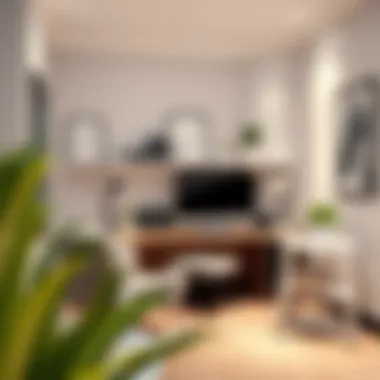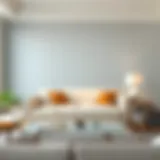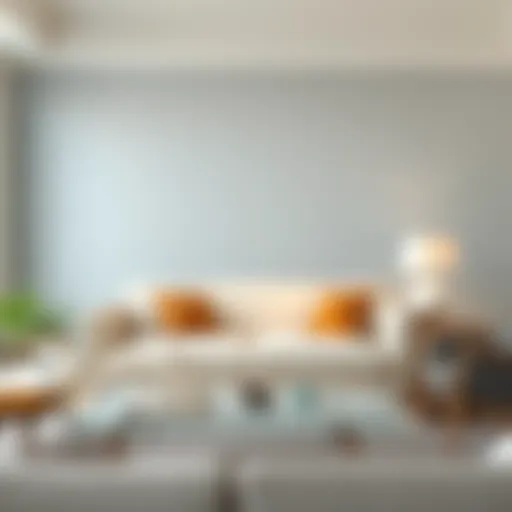Creative Ways to Enhance Your Room's Corners


Intro
Corners often go unnoticed in a room, tucked away like forgotten treasures. Yet, with a bit of creativity and a dash of innovation, these spaces can be transformed into striking features or functional areas that enhance the overall design of your home. Whether you are an avid DIY enthusiast or a seasoned interior designer, understanding how to utilize every square inch of your space is essential. This guide aims to inspire homeowners, decorators, and renovators by presenting novel ideas for these overlooked nooks. Let's unpack the potential lurking in the corners of your home!
Furniture Styles and Trends
Exploring Popular Furniture Styles
The choice of furniture not only influences the aesthetic appeal but also the functionality of a room's corner. Furniture styles have evolved greatly, embracing designs that cater to both form and function. For instance, Scandinavian minimalism brings simplicity and warmth to a corner with its natural wood hues and clean lines. On the other hand, mid-century modern pieces can inject a sense of nostalgia and style, often featuring tapered legs and bold colors.
Moreover, multifaceted furniture is gaining traction. Think ottomans that double as storage or shelving units that serve as room dividers. This trend reflects a growing preference for versatility in home decor, allowing corners to be more than just a resting place for miscellaneous items.
Understanding Current Design Trends
Current trends lean towards sustainable and reclaimed materials, where furniture is crafted from eco-friendly options. Using furniture made from bamboo or recycled wood not only makes the corner sustainable but also adds a unique character to your space.
Furthermore, biophilic design is emerging as a result of our innate connection to nature. Integrating indoor plants into corner spaces not only beautifies the area but also improves air quality. Pairing a stylish plant stand with trailing vines can create a little green sanctuary, serving as a focal point.
"A well-placed piece of furniture can redefine a forgotten corner, bringing elegance and utility into a fresh perspective."
Practical Tips for Furniture Selection
Factors to Consider When Choosing Furniture
Selecting the right furniture for your corner demands some thought. First off, consider the scale. Oversized furniture can make a corner feel cramped, while petite pieces might get lost in a spacious setting. Aim for a balance that complements the dimensions of the room.
Color is another critical element. Lighter shades can create an illusion of space, whereas darker tones can add depth but may make the corner feel somewhat enclosed. Mixing textures, too, adds interest without overwhelming the senses.
How to Measure and Optimize Space
Before making any purchase, it's crucial to measure your space accurately. Use a tape measure, jotting down the dimensions of the corner. Here are some practical pointers:
- Draft Layouts: Sketch different arrangements to visualize how the furniture fits.
- Floor Planning Apps: Try online tools that let you drag and drop furniture to simulate your layout.
- Mock-Up Scale Models: Consider using painter's tape to outline where furniture might go, aiding in understand the space.
Incorporating considerations for movement is vital. Ensure there’s enough room to navigate comfortably without bumping into pieces. This not only improves functionality but creates a flow throughout your living space.
Understanding the Importance of Room Corners
Room corners often get overlooked, but their potential is vast, offering functional and aesthetic advantages. With the right mindset and creativity, these spaces can enhance the overall design of a room, providing both practicality and style.
In any room, the corners can shape the atmosphere. They are more than just leftover spaces. Rather, they can serve as anchors for furniture arrangement, create zones in open layouts, or act as hidden storage locations. By maximizing these areas, one can develop a cohesive design that speaks of thoughtfulness and functionality.
Defining the Role of Corners in Interior Design
Corners play a crucial role in the flow of a space. Think of them as the framework that organizes a room. When you walk into a living area, for example, your eyes may naturally gravitate towards the corners, feeling the room's balance and structure. An empty corner can create a sense of disarray, while a well-decorated one can tie everything together.
Utilizing corners cleverly can thus enhance both usability and design cohesion. They can be turned into reading nooks, art displays, or practical storage, ensuring every inch of the room serves a purpose.
Functional vs. Aesthetic Considerations
When it comes to room corners, there’s often a tug-of-war between functionality and aesthetics. Understanding this balance is key.
Functional considerations focus on how these spaces can serve everyday needs. For instance, a corner shelf not only saves space but organizes your books efficiently. It’s about making life easier through practical solutions.
On the other hand, aesthetic considerations are about the look and feel. A beautifully designed corner might include a piece of art, delicate lighting, or a well-placed plant. It makes the area visually appealing and inviting.
Ultimately, finding a sweet spot where functionality meets aesthetics is paramount. Think of it like a two-way street: when you design for one aspect, don’t neglect the other.
Effective corner utilization is about creating spaces that are both beautiful and functional. Aim for a harmonious blend, and every room will benefit.
Types of Corners in Different Rooms
When it comes to home design, corners are often the last spaces we think of utilizing. Yet these areas can hold immense potential, and understanding their unique characteristics in various rooms is essential. Using these nooks effectively can enhance both functionality and aesthetics. Each type of room invites a different angle on corner usage—literally. Let's break down how living rooms, bedrooms, kitchens, and home offices can transform often unconsidered corners into focal points that serve specific needs.
Living Room Corners


The living room serves as the heart of a home, a multifunctional space where family and friends gather. Corners in this setting should be more than just an afterthought.
- Reading Nooks: Picture a tall bookshelf reaching the ceiling, snugly fit into the corner, adorned with a plush armchair beside it. This simple arrangement transforms a corner into a cozy reading nook. An overhead light can amplify this effect, creating a warm retreat for anyone looking to escape into the pages of a good book.
- Display Areas: Display shelves can work wonders in corners. Consider floating shelves that can hold decorative items, plants, or family photos. This not only capitalizes on vertical space but also draws the eye, inviting guests to explore your curated treasures.
“A well-utilized corner can become a conversation starter – it’s about creativity and function working hand in hand.”
Bedroom Corners
In a bedroom, the corner can be transformed into a sanctuary of relaxation. Here, the focus tends to lean towards comfort and personal style.
- Bedside Tables: A corner can accommodate a bedside table or a small nightstand adorned with a lamp and books. This can give symmetry to your bed while also creating a functional space for essentials.
- Dressing Areas: Another option is to create a mini dressing area by placing a stylish chair and a mirror in the corner. It’s a great touch for getting ready in the morning and can make the most of any unused space.
Kitchen Corners
Kitchens, often buzzing with activity, can also exploit corners for inventive storage and workspace solutions.
- Corner Cabinets: Instead of allowing corners to go unused, consider corner cabinets with rotating shelves. This simple addition can add a world of functionality by making ingredients and appliances more accessible.
- Breakfast Bar: If space allows, a small breakfast bar can fit neatly into a kitchen corner, providing an intimate eating space for breakfast or casual meals. With some stools, it can serve as an informal dining area.
Home Office Corners
As more people work from home, finding a comfortable workspace is crucial. Corners in a home office might be the best-kept secret for an efficient setup.
- Corner Desks: A corner desk offers ample workspace without taking up much room. It can provide a cozy nook ideal for focusing on tasks while keeping distractions to a minimum.
- Storage Solutions: Installing wall-mounted cabinets or shelving in corners can create additional storage that keeps office supplies organized yet accessible. This helps maintain a clean workspace free from clutter.
Understanding the functional anatomy of corners in different rooms allows for a thoughtful layout that maximizes both aesthetic appeal and utility. Each room presents its own challenges and opportunities, inviting creativity and personalized solutions.
Functional Furniture Ideas for Corners
Maximizing the potential of room corners requires a thoughtful approach to functional furniture ideas. Corners, often neglected, can transform into vibrant areas of utility and style. By integrating smart furniture choices, homeowners can not only enhance the aesthetics of their living space but also create areas tailored to specific needs. The right furniture can turn an awkward nook into a cozy reading corner, a productive workspace, or an organized storage area. It's essential to balance form with function to ensure that each piece serves a purpose while fitting seamlessly into the overall design.
Corner Shelves and Bookcases
Corner shelves and bookcases offer a fantastic solution for anyone looking to maximize vertical space. These pieces can transform any corner into a mini-library or display area for treasured belongings. A well-placed shelf allows you to utilize vertical space without cluttering the floor, making the room feel larger and more inviting.
There are various styles to choose from, such as:
- Floating Shelves: These can be mounted to the wall, providing a sleek and modern look.
- Ladder Shelves: Their unique design allows you to display items while keeping things accessible.
- Corner Bookcases: Designed to fit snugly into the corner, these are perfect for displaying books, plants, or decorative pieces.
Incorporating corner shelves into your design can encourage creativity as well. For instance, you could use them to showcase framed photos, house plants, or even small art pieces that spark joy.
Corner Desks and Workstations
For those who find themselves working from home or needing a dedicated study space, corner desks and workstations can be a game changer. They allow you to turn an otherwise underutilized area into a productive spot.
A corner desk optimizes the workflow and can include various features, such as:
- Built-in Storage: Drawers and shelves can keep your workspace organized.
- Adjustable Height Options: Many modern desks are flexible to accommodate standing or sitting positions.
- Minimalist Designs: Sleek designs help save space and reduce visual clutter.
Setting up a workstation in a corner not only promotes productivity but can also mitigate distractions. With minimal furnishings, there’s less of a chance to be distracted by the surrounding room.
Seating Solutions: Chairs and Benches
Seating solutions in corners can create cozy spots for relaxation or conversation. By incorporating chairs and benches, you can develop inviting nooks that are perfect for unwinding with a book or livening up the space for social gatherings.
Consider:
- Corner Sofas: These are incredibly effective if you have a spacious room, offering ample seating while defining the area.
- Accent Chairs: Select bold patterns or colors to enhance the style and provide comfortable spots to sit.
- Benches: They can serve dual purposes—offering both seating and storage.
Adding soft cushions or throws can enhance comfort and style, making the space even more inviting. A corner seating arrangement promotes intimacy whether it’s part of an extensive living setup or a small, personalized nook.
Decorative Ideas to Enhance Corner Space
When it comes to the overall aesthetic of a room, corners often end up neglected. Yet, embracing these spaces with decorative ideas can significantly elevate the ambiance and functionality of your home. Utilizing corners effectively isn't only about practicality; it's also about creating a visual impact that draws the eye and enhances the overall design.
The beauty of corner spaces lies in their potential to become focal points. With thoughtful selections of art, greenery, and lighting, even the coziest of nooks can be transformed into an inviting and serene locale. Corner walls can serve as blank canvases, waiting to be tastefully adorned to reflect your personality and style.
Art and Wall Hangings


Art has the power to transform a simple corner into something extraordinary. Hanging larger pieces can create a stunning visual statement, while smaller items can form an eclectic gallery wall. Here are some points to consider:
- Scale Matter: Depending on your corner’s size, choosing the right scale of artwork is crucial. A towering canvas can add drama in spacious areas, while a cluster of smaller framed pieces can create a coordinated, intimate feel.
- Telling a Story: Select art that resonates with you. It could be personal family photos, travel memorabilia, or local art that evokes memories. This connection adds warmth to the space, making it feel more lived-in and inviting.
- Display Techniques: Use floating shelves to lean art against the wall, combining it with other decorative items. This offers an opportunity to swap pieces without needing to rehang.
“Art is not what you see, but what you make others see.” – Edgar Degas
Plants and Greenery
Incorporating plants into your corner spaces introduces life and color, enhancing the atmosphere in ways that other decor can't achieve. Houseplants purify the air, making your environment healthier, and they can also serve as unique decor. Consider the following:
- Select the Right Varieties: Choose plants suitable for the amount of sunlight the corner receives. Snake plants or pothos thrive well in low light, while succulents enjoy bright spaces.
- Layering Heights: By using various heights and textures, you can create a dynamic display. Use plant stands or hangers to give dimension to your corner.
- Creative Containers: Think outside traditional pots. Mason jars, decorative baskets, or even repurposed antique containers can add character while still offering the benefits of greenery.
Lighting Options for Corners
Lighting plays a significant role in defining the mood of your space. Well-placed lighting in corner areas can prevent dark shadows and create an inviting glow. Here’s how to utilize this element:
- Floor and Table Lamps: Tall floor lamps can beautifully illuminate corner spaces, acting as both functional light sources and aesthetic pieces. Similarly, an attractive table lamp on a corner shelf or side table can infuse charm.
- Accent Lights: Consider wall sconces for a more subtle glow. They can create warm shadows and add elegance without taking up floor space.
- Dimmers: Installing dimmer switches allows you to adjust the intensity of the light based on the time of day or the occasion, providing flexibility in how your corner feels.
By paying attention to these decorative ideas for corner spaces, you unlock a world of creative possibilities that can significantly contribute to the overall charm and functionality of your home.
DIY Projects for Corner Utilization
Unlocking the potential of room corners takes a blend of creativity and practicality, and DIY projects form the perfect bridge between those elements. No longer perceived as wasted space, corners can become vibrant parts of a home with just a few carefully considered changes. Engaging in DIY projects not only allows homeowners to exercise their creativity but also gives them the satisfaction of creating something uniquely tailored to their space.
Building Custom Shelving Units
When it comes to corners, custom shelving units can be a game-changer. Instead of settling for standard shelves that might not fit your dimensions, creating a custom unit allows you to maximize that corner with precision. Building these units provides an opportunity to utilize trimmings, finishes, and colors that complement the rest of your room.
Here’s how you can start:
- Measure your space carefully to ensure an ideal fit. Take into account the angle and width of the corner.
- Choose materials that match your home’s current aesthetic—whether that’s reclaimed wood for a rustic touch or sleek metal for a modern vibe.
- Design your layout. Think about what items you truly wish to display or store. Consider incorporating a mix of open shelves and enclosed spaces for versatility.
Building a custom shelving unit not only enhances organization but adds aesthetically pleasing aspects to your design. They can look stunning, whether you’re showcasing books, plants, or decorative items.
Creating a Reading Nook
Ah, the beloved reading nook! Corners are a natural fit for these cozy hideaways. Imagine curling up with your favorite book, surrounded by a thoughtful blend of comfort and design. Creating this space can be as simple or elaborate as you desire.
Think about these elements:
- Seating: A petite armchair or a cushy floor cushion can transform a boring corner into a welcoming nook.
- Lighting: Consider adding a lamp that suits the setting. The right lighting can make or break a reading corner.
- Accessories: Personal touch is vital, add throw pillows, and blankets, or even wall-mounted book storage to keep everything inviting.
This type of project serves more than just aesthetics; it’s about self-care and creating a personal retreat. Consider indulging in a comfortable space where one can escape from the chaos of daily life.
Repurposing Furniture for Corner Use
If there’s one thing every homeowner tends to have, it’s excess furniture. Instead of letting that old ladder, trunk, or small table gather dust in the garage, consider repurposing it to fit neatly in a corner. This creative recycling not only saves you money but also adds a unique charm that store-bought items often lack.
Here are some ideas for repurposed furniture:
- Ladders: Lean a decorative ladder against the wall and use it to display plants or as a bookshelf for your beloved reads.
- Old trunks: A vintage trunk can serve as a stylish storage option and a unique tabletop for a couple of accent pieces.
- Tables: Small side tables can become corner stations for your plants or as a spot to rest an evening drink.
By embracing these DIY projects, you engage with your living space on a deeper level. You’re not just rearranging; you are redefining how you experience the corners of your home, almost writing a story with each piece you add. Embrace the process, and you may find that these corners become your new favorite areas.
Color and Texture Considerations
When it comes to enhancing the corners of a room, color and texture play a pivotal role. These elements not only contribute to the overall aesthetic appeal but also have the potential to influence the mood and atmosphere of the space. The right shades can create an inviting ambiance, while various textures can add depth to what is often seen as the forgotten parts of a room. Failing to consider these factors may lead to lackluster corners that do not align with the style of the rest of the area. Communicating a consistent visual narrative is essential in creating cohesion throughout your home.
Choosing the Right Paint for Corners
Selecting the appropriate paint color for corners can significantly affect the perception of space. Light shades, like soft pastels or light neutrals, can make corners feel airy and open, while darker hues can establish a sense of intimacy. For example, painting a corner in a rich navy blue might evoke a cozy reading nook whereas a pale green offers a refreshing feel.
When putting brush to wall, it’s essential to consider the surrounding colors and the natural light available. Corners that lack sunlight can handle darker shades as they may prevent the area from feeling too cramped. Alternatively, corners bathed in natural light can play host to more daring color choices, presenting a vibrant backdrop for shelves or decorative items.
- Tip: Don’t be afraid to use contrasting colors to distinguish corners. This technique can bring function to the forefront while emphasizing architectural features.
Using Textiles for Added Warmth


Textiles are an excellent way to inject warmth and character into corners. A simple solution can be as straightforward as adding a plush throw or decorative pillows to a corner chair or bench. This not only prompts a sense of comfort but also creates a visually appealing layer to the space.
In addition to throws and cushions, consider draping fabric around the corner or incorporating a tapestry. Consider a soft wool or a textured fabric for balance. Corners often experience a lot of visual hard edges, textile can soften these lines and lead the eye into the space smoothly.
- Incorporating Area Rugs: Placing a small area rug in a corner can define the area and create a sense of separation, even in an open room.
- Palette Coordination: Make sure the textiles coordinate with the broader color scheme of the room to prevent visual chaos.
Using thoughtful selections of color and texture, the corners of any room can transform from mere afterthoughts into vibrant parts of your living space.
Challenges of Corner Spaces
Corners are often an afterthought in room design, leading to their underutilization or neglected potential. However, understanding the challenges of these areas is crucial, especially when tackling the broader topic of innovative corner utilization. As homeowners and interior designers strive to create functional and aesthetically pleasing spaces, acknowledging the specific hurdles that corners present can pave the way for effective solutions. The challenges stem from factors like limited space, access, and movement, which, when addressed, can lead to a transformation in how these spaces are perceived and utilized.
Dealing with Limited Space
One of the primary issues in corner spaces is inherent spatial limitations. These areas can often feel confined, especially in smaller rooms where every square foot counts. As a designer, it’s essential to approach this challenge with a mindset that prioritizes smart design choices over sheer size. Rather than attempting to fill the corner with oversized furniture or excessive decor, consider smaller, multi-functional pieces that provide utility without overwhelming the area.
- Opt for slim furniture: Look for items like corner bookcases or thin console tables that can fit neatly into the nook.
- Create vertical storage: Take advantage of the height by installing shelves that draw the eye upwards, enhancing the illusion of space.
- Use quality materials: Choosing lightweight materials can help convey a feeling of openness, avoiding the cramped sensation common with bulkier designs.
By thinking outside the box, you can make even the smallest corners work wonders, turning a potential burden into a real asset.
Ensuring Access and Movement
Another factor to bear in mind is the necessary balance between design and function, specifically regarding access and movement. Picture a well-decorated corner that looks stunning but hinders traffic flow: aggressive design without practical considerations can lead to frustration. Leaving enough room to move comfortably around furniture is vital for a space to feel inviting.
- Maintain flow: Arranging furniture to facilitate natural pathways can make corners feel less awkward. A common approach is situating a chair at an angle to allow easier access to adjacent areas.
- Establish clear zones: Define your corner’s purpose – whether it’s an office nook, reading alcove, or decorative display area – and design around that function, ensuring it doesn’t impede movement from one part of the room to another.
- Consider layouts: Sketching out idea layouts can help visualize how the corner will interact with the rest of the space before committing to specific pieces.
“A well-designed corner can serve multiple purposes without feeling crowded or disengaged from its surroundings.”
Balancing accessibility with creative design strategies fosters a space that not only looks good but feels right, making it truly livable. Thus, by addressing the constraints of corner spaces, you can ultimately unlock their potential, contributing to a more harmonious home. Ensuring movement through careful design can significantly enhance the efficiency and enjoyment of your space.
Incorporating Technology in Corner Spaces
In today’s fast-paced world, incorporating technology into our living spaces is more crucial than ever. The corner of your room, often an underestimated area, has tremendous potential to house various tech solutions that can enhance your lifestyle. By thoughtfully integrating technological elements, you can turn these neglected spots into power hubs that not only make your life easier but also add a contemporary flair to your home.
Smart Home Features
With the rise of smart home technology, corners are becoming prime locations for integrating intelligent devices that streamline daily tasks. Smart speakers like Amazon Echo or Google Nest are perfect for placing in a corner, allowing them to distribute sound evenly throughout the room. These devices can serve as command centers, enabling you to control light, temperature, and music with just your voice.
Furthermore, smart plugs are an excellent way to make any device a little smarter. When placed in a corner where multiple cords gather, you can transform traditional lamps or appliances into smart devices. Imagine sipping your morning coffee while simply saying, “turn on the kitchen lights,” and voila—no fumbling in the dark.
"Tech in your corner can simplify life in ways you didn’t even think possible."
These features not only enhance convenience but also help in energy management. For instance, using smart thermostats allows you to set your heating or cooling system from the comfort of your couch, ensuring no energy is wasted.
Entertainment Systems in Corners
Corners have long been overlooked when it comes to entertainment systems, but this oversight is changing. With the right planning, you can utilize corner spaces to create impressive home theater setups. Corner TV stands maximize the space and provide an angled viewing experience that’s comfortable for the whole family without sacrificing floor space.
Consider a wall-mounted TV in the corner, paired with a soundbar that can nestle snugly along the wall. This approach ensures that your entertainment system is both functional and stylish. With sleek designs available, a corner setup can transform your room into a cinematic haven.
In addition, consider integrating gaming consoles or streaming devices into your corner space. Consoles can be set up on corner shelves or media cabinets, keeping them out of the way until needed. You can easily manage cables by using corner cable management systems to conceal unsightly wires, maintaining a clean aesthetic.
By creatively merging technology with corner spaces, you're not just optimizing the area; you're enriching your entire home experience. With innovative solutions tailored for corners, you can have both functionality and style coexist seamlessly.
Final Thoughts on Maximizing Corners
Maximizing corners in our rooms is like finding the hidden gems in a treasure chest. It’s easy to overlook these spaces, but with a little creativity, they can become standout features of your home. Properly utilized corners not only enhance the functionality of a room but also contribute to the overall aesthetic appeal. By integrating innovative ideas and functional design, homeowners can transform corners from mere afterthoughts into elegant, purposeful spaces.
The Future of Corner Design
As we look ahead, the design of corners is evolving, much like the way our lifestyles are changing. Future interior designs will likely focus on adaptability and multifunctionality. Incorporating modular furniture can create flexible, interchangeable solutions that cater to varied needs, whether it’s a cozy reading corner or a small workspace. A trend that's gaining steam is the use of technology within these spaces. Think about adjustable shelving units that can morph to suit purposes over time or dynamic lighting that adjusts according to activity.
The trend of biophilic design—bringing nature indoors—is also set to play a significant role. Incorporating plants or natural elements in corners can enhance both aesthetics and air quality, bridging the gap between indoor living and the natural world. Moreover, we might see advances in smart home features, like hidden tech in furniture, making these spaces not just aesthetic, but highly functional as well. Ultimately, the future of corner design is headed toward a blend of functionality, technology, and personal style, encouraging residents to make every inch of their homes work for them.
Encouraging Personalization and Creativity
Each person's home tells a story, and corners are great places to let that narrative unfold. Personalization and creativity should be at the heart of corner utilization. Homeowners should feel empowered to express their unique tastes. Some suggestions include:
- Showcasing personal collections: Whether it's travel souvenirs or family photos, use corners to highlight what makes you, you.
- Artistic displays: Corners are perfect for showcasing an oversized piece of art or an eclectic mix of wall hangings that inspire discussions.
- DIY projects: Engage in custom projects, such as a homemade book nook or a small gallery wall, to bring a personal touch.
Creativity doesn't have to stem from the conventional. Consider unconventional materials or layouts that might catch someone off guard in the best possible way. Even old furniture can find new life in corner spaces—a coat of paint or some rearranging might do the trick.
Just remember, the key to maximizing your corner space lies in your own preferences, usage, and style. Your home is a reflection of who you are, and corners are the quiet canvases just waiting for your artistry to shine.















